First Time Flying Alone – Ultimate Step-By-Step Guide (2023)
My first time flying alone was turbulent.
I lost my bag-tag two minutes after checking in. I held up the line at security for 10 minutes. I made my connecting flight with a minute to spare. And by the time I landed my phone was dead.
Don’t be like me – start your solo trip on the right path. Study this ultimate guide before flying by yourself for the first time.
Nomadic Yak has 100s of solo travel tips if it’s your first time travelling solo!
First Time Flying Alone: Quick Checklist
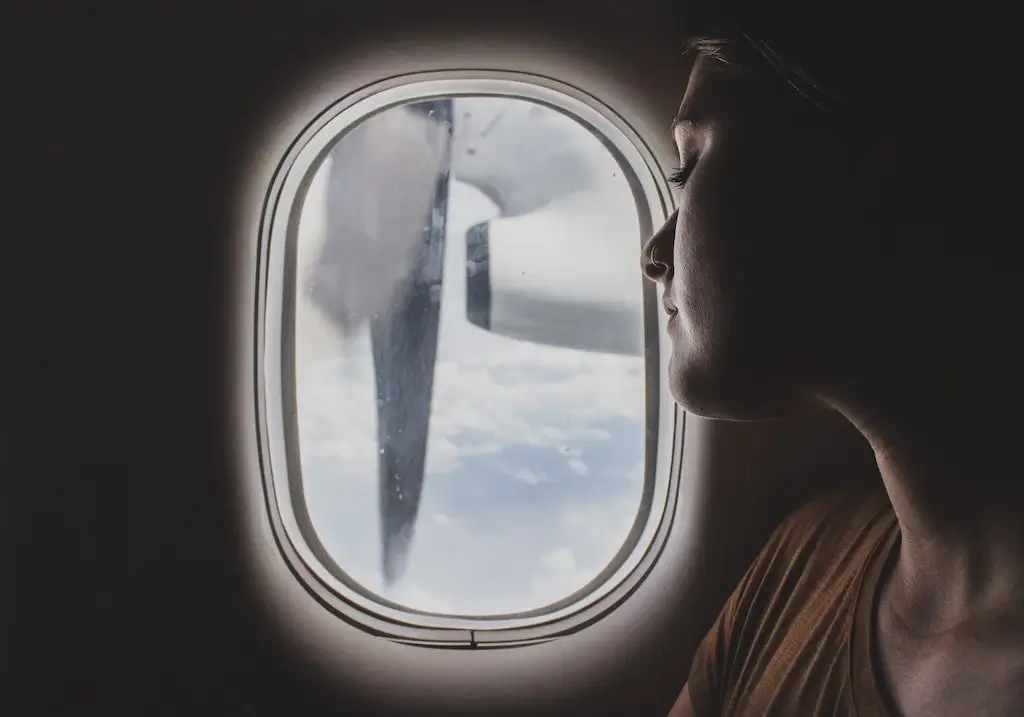
Want a rapid overview of what to do when flying for the first time by yourself? Here is a 10-point checklist of the main things to remember when flying alone:
- Prepare your travel documents: Have your airline tickets, visas, passport and other travel documents printed, saved digitally and ready to go.
- Check the luggage requirements: Ensure that the weight and size of your bags are within the luggage allowances. Store all liquids, electronics and batteries in your hand luggage as per requirements.
- Arrive at the airport early: Most airlines require you to arrive at the airport at least 2 hours prior to a domestic flight, and at least 3 hours prior to an international flight.
- Check-in online or in person: Check-in for your flight online up to 24 hours before departure. If online check-in is not available, check-in in person at the airport. You will receive a boarding pass.
- Drop off your baggage: Drop off your checked luggage at the airline check-in counter. You will receive a small sticker called a “bag tag” for tracking your luggage.
- Pass through departure immigration and security: Have your passport scanned or stamped. Remove electronics and liquids from your hand luggage. Have your hand luggage and your body X-rayed for banned items.
- Be at the gate by boarding time: Be at your boarding gate at least an hour before your time of departure.
- Prepare for take-off and landing: Find your seat, stow away your hand luggage and loose items, fasten your seatbelt and secure your dining tray.
- Pass through arrival immigration (International flights only): Have your passport stamped by an immigration officer or scan your passport at an electronic immigration gate.
- Pick up your baggage: Find the right conveyor belt and pick up your checked luggage. Speak to the lost luggage staff if your bags don’t arrive.
For more details on all the above, see the comprehensive step-by-step guide below.
Nervous about travelling alone? I list 15 dangers to beware in my article: is solo travel safe?
First Time Flying Alone: Step-By-Step (Detailed Checklist)
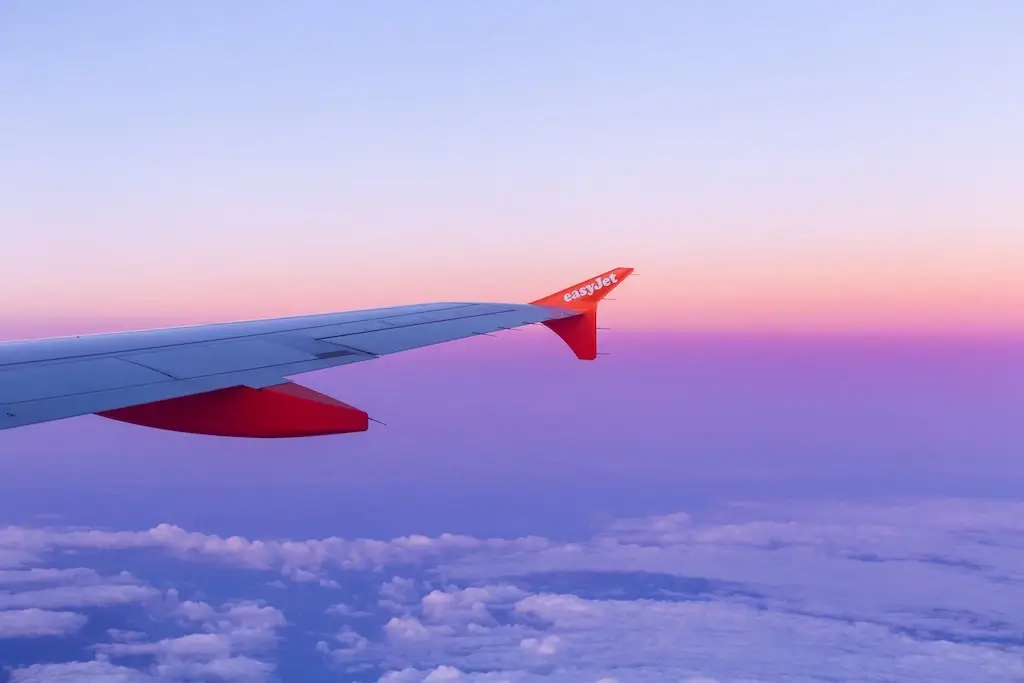
This 30-point guide walks you through your first time flying alone step-by-step.
It includes comprehensive information on what to do during your first time flying alone, including; preparing for your flight, at the airport, during your flight, during your layover and upon arrival.
It can be used for both international and domestic flights alone.
Preparing for the Flight
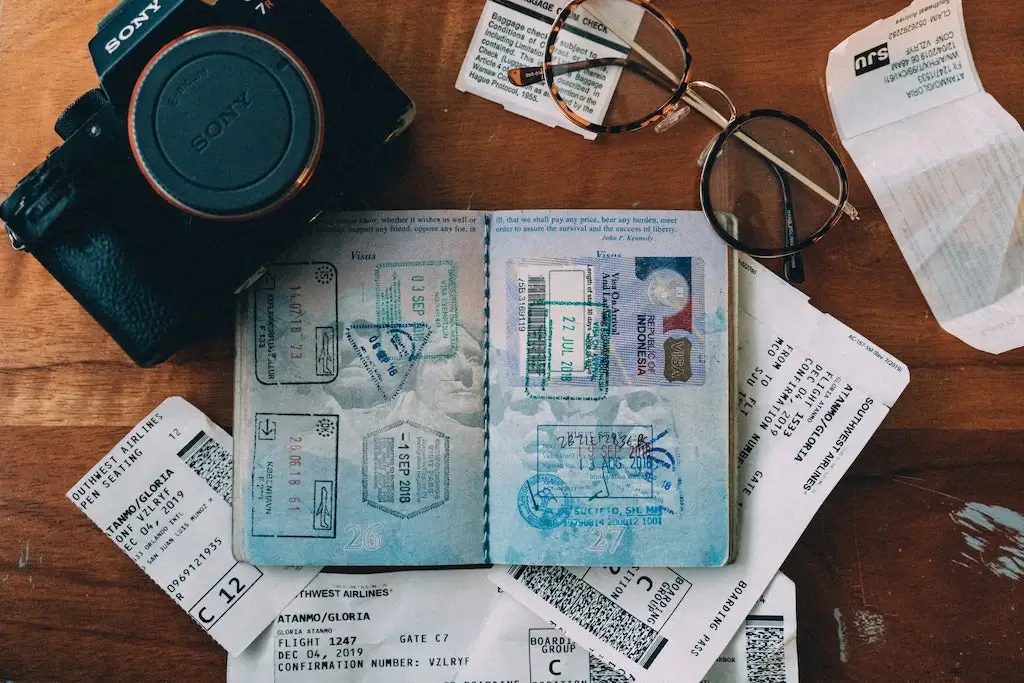
1. Choose a travel destination and dates
If you’ve already chosen a destination and travel dates, skip this step.
But if you don’t know where to take your first trip alone, search my solo travel destination guides. Find your next adventure based on your budget, safety, experience, age and more.
Note that flights are cheapest during the off-season (May-June and August-October). Avoid travelling during the peak holiday periods (December to January).
Further, flights are cheapest if you book between 4 months to 3 weeks in advance.
2. Check visa requirements and apply
Wait! Don’t book your first flight alone just yet. You need to check that you are eligible to travel to your destination.
Search for your destination on your government’s travel advisory website. Advisories include:
- Travel.State.Gov (USA)
- Foreign Travel Advice (UK)
- Travel.gc.ca (Canada)
- Smart Traveller (Australia)
Is your intended destination safe to travel to? What level of precaution is required? Can your government assist you in an emergency? Are there entry/exit requirements?
You can also use the Passport Index to check what type of visa you need for your destination.
If you have to apply for a visa or an eVisa, always doublecheck that you are using the official government website. Only provide payment if the site is trustworthy. I have been ripped off by dodgy online visa processes (e.g. the Egyptian eVisa).
3. Compare available flights
You’ve chosen a destination, picked your travel dates and attained a visa. Now you can shop for flights.
Use comparison sites like Google Flights and SkyScanner. You’ll save hours trying to find the cheapest and shortest flight to your destination.
Tip: Don’t take a 30-hour flight via the middle-of-nowhere to save $100. You’ll be grateful for having chosen a shorter, more comfortable and less-complicated flight.
4. Research the airline
Before pulling the trigger and booking your first flight alone, doublecheck the reputation of the airline.
Search your chosen airline on SkyTrax. See their safety ratings and read user reviews about the:
- Food and beverages
- Inflight entertainment
- Seat comfort
- Staff service
- Value for money.
It’s also worth Googling the airline’s baggage allowances. Does the airline provide enough luggage allowance or will you end up paying extra fees?
I suggest that most solo travellers need 20-30kg of baggage allowance.
5. Pay and book the flight
Once you’ve chosen an affordable and direct flight with a reputable airline, it’s time to book and make payment.
Book directly through the airline website rather than a third-party site. It is more convenient. You get immediate access to the booking management system (e.g. seat selection). Plus, you deal directly with the airline’s customer service if your flight is delayed, cancelled or changed
Third-party sites do often offer better ticket prices. But be warned – many third-party sites have subpar customer service (i.e. slow to respond). They may not be able to help you if your flight plans change.
6. Select a seat or other extras (optional)
If you are concerned about where you sit on your first flight alone, you may want to pay extra to choose a seat.
I always suggest avoiding the middle seat in the row. It is uncomfortable being wedged between two people.
Want to be able to stand up and stretch your legs without annoying other people? Sit in the aisle.
Or are you wanting to see the scenery during your first time flying alone? Sit in the window.
7. Plan your layover (optional)
If your first flight alone has a layover, check how long the layover lasts.
If the layover only lasts a few hours (i.e. less than 8 hours), it is best to remain at the airport.
But if the layover lasts for more than 8 hours, you may want to book accommodation inside or close-by to the airport.
Also, check your flight documents regarding your luggage. Will your baggage be automatically transferred to your onward flight? Or do you have to re-check your luggage during the layover?
If your onward flight (after the layover) is booked with the same airline, the baggage should be automatically transferred. But if the onward flight is with a different airline, you may have to claim and re-check your baggage during the layover.
8. Prepare your travel documents
Have all your essential travel documents ready before taking your first flight alone, including:
- Airline tickets
- Passport
- Visas
- Proof of funds (e.g. bank statement)(if required)
- Travel insurance certificate (if required)
- Vaccination certificate (if required)
- Return ticket and itinerary (if required).
Most of these documents will be saved to your phone. But be sure to save them locally on your phone (or screenshot) in case you can’t connect to the internet.
You should also print out these documents. That way, you can access them if your phone dies.
Tip: Scan your passport and save a copy on your phone for easy access (just 1 of my 35 solo travel safety tips).
9. Doublecheck your luggage
Your ticket should indicate a luggage allowance. This tells you how much your check-in luggage and hand luggage can weigh.
The airline may also restrict the size of the bag.
When packing your bags, make sure that you don’t exceed the luggage allowance. If you do, you will be charged an extra fee at the airport or asked to leave some of your luggage behind.
If you need a larger luggage allowance, you can buy this through the airline’s booking system.
Liquid, aerosol and gel items must be stored in a container of 100ml or less. Then, those containers must be placed inside a transparent and resealable plastic bag. These bags are usually available at the airport before the security check.
If you are travelling with batteries (e.g. a portable power bank), they must also be stored in your hand luggage.
10. Arrange transport to and from the airport
The most affordable and stress-free way to get to the airport is to have a friend or family member drop you off.
If you don’t have this option, pre-arrange for an Uber, taxi or airport shuttle service to take you to the airport. Don’t wait til the morning of your flight because you will run into problems and arrive late.
You also need to consider what you will do when you arrive at your destination. How will you get from the airport to your accommodation?
Many international airports offer shuttle or train services to the city centre. Alternatively, ask your accommodation to help you arrange an airport transfer.
11. Check-in online
Most airlines will allow you to check-in online up to 24 hours before departure.
Check-in as soon as you receive an email or text message from the airline telling you that check-in is open.
The check-in process usually asks you to confirm basic details (e.g. name and passport number). Once complete, you should be provided with an electronic boarding pass. If you don’t receive a boarding pass, you might be advised to pick it up at the airport.
If you can’t complete the online check-in, you will have to check-in in person at the airport upon arrival. This has happened to me several times in Europe because the online check-in system did not recognise my Australian passport.
Arrival at the Airport
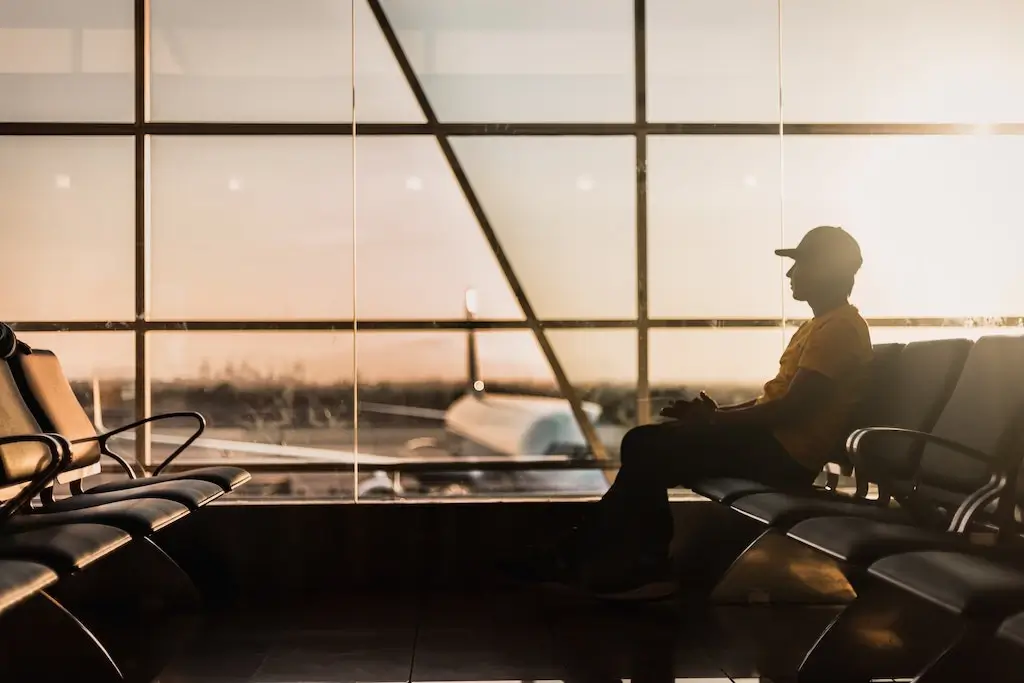
12. Take your transport to the airport
It’s time to go! Have all your luggage ready at the door, so that you don’t leave anything behind.
Plan your journey so that you will arrive at the airport about 2-3 hours before your flight.
13. Arrive 2-3 hours before your flight
Most airlines require you to arrive at the airport at least 2 hours prior to a domestic flight, and at least 3 hours prior to an international flight.
Check your flight booking for a precise airport arrival time.
If you miss the check-in window, you may not be allowed to board the flight. Most flights are oversold and the last customers to arrive are often asked to take another flight.
14. Physical check-in and luggage dropoff
If you did not receive a boarding pass when you checked-in online, you may need to pick it up at the airport.
If you’re only travelling with hand-luggage, you may be able to use a self-serve computer kiosk. Enter your flight details and print-out your boarding pass. Done – you can proceed to the next step.
But if you are travelling with checked luggage, you will need to approach the drop-off counter. Find the right counter by looking for the screens with your airline and flight number.
At the counter, a staff member will ask for your flight details and passport. They will then weigh your big bag, tag it and transfer it to the flight. You will get a boarding pass and a sticker with your luggage number.
Don’t lose the sticker – you’ll need it to track down your checked luggage if it becomes lost.
15. Pass through departing immigration (International flights)
You may be required to pass through immigration before departing your home country.
Most modern airports have passport scanners that make this process very simple. Just walk up, put your passport face down in the scanner, look up at the camera and wait for the gate to open before proceeding.
Other countries may require you to fill out an immigration departure form. After filling out the form, you may be required to give it to an immigration agent or drop it in a box.
16. Pass through the security checkpoint
Join the line to go through the airport security check. Read the signage for instructions.
Approach the security table and take a tray. Remove any electronic items and liquids from your hand luggage. Remember, your liquids must be within a sealed transparent bag. Place the items flat in the tray.
You may also need to remove your shoes, hat, jacket, jewellery, watch, belt and wallet. Place these items in a separate tray with your hand luggage (i.e. backpack or handbag). Hold on to your passport and boarding pass.
Push the trays on to the conveyor belt so that they pass through the X-ray machine.
Proceed through the security gate as advised by the staff. They may ask you to pause so that they can X-ray your body. If you set-off the X-ray machine, they may pat you down or wave a detector wand over your body.
If there are any prohibited items within your hand luggage, the security staff will ask you to open the bag and take them out. They may throw out any banned items that you can’t take on the flight.
The staff may also swab your bag or possessions for drugs or explosives.
Once the staff let you proceed, pick up your trays off of the conveyor belt. Take the trays to a table if available. Repack your hand luggage and put on your shoes and accessories.
Note: Some modern airports no longer ask you to remove electronic devices from your bag. Read the signage.
17. Find your gate and boarding time
Your boarding pass will state a boarding time.
Note that the boarding time (the time you get on the plane) is not the same as the time of departure (the time the flight takes off). The boarding time is often an hour before the time of departure.
Find your gate by looking at the screens that show your flight number and gate number. Follow the signs around the airport until you arrive at your gate.
Boarding and In-flight Experience
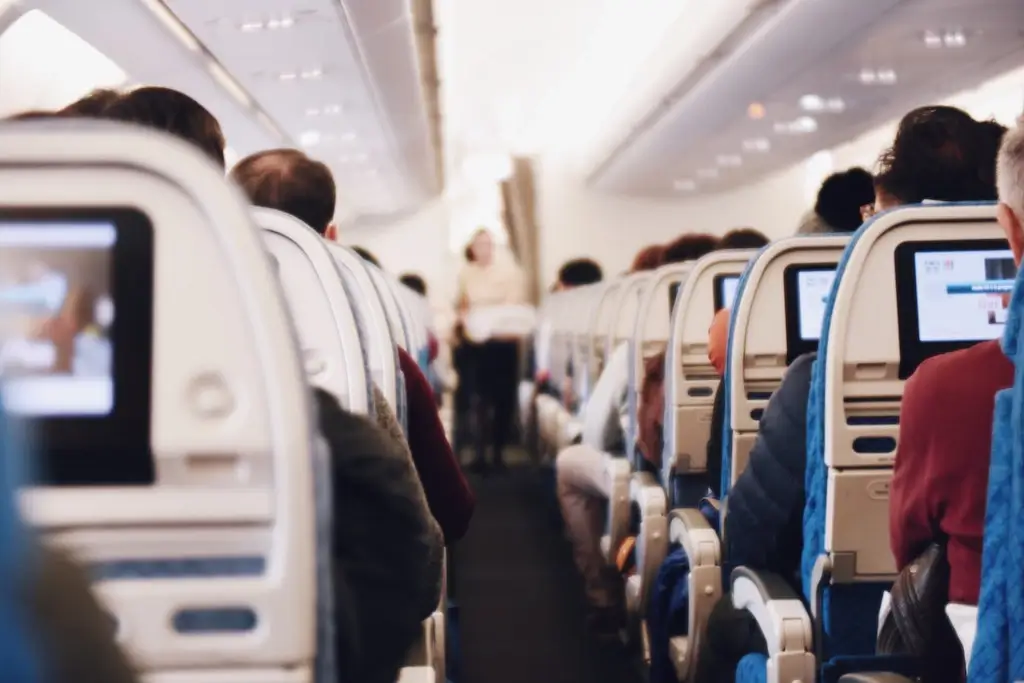
18. Wait at your boarding gate
Be at your boarding gate at least an hour before your time of departure.
If you have time to kill before your boarding time, you may want to get some food or visit the stores in the airport.
But whatever you do, don’t miss your boarding time! And keep an eye on the displays in case your gate or boarding time changes.
19. Board the plane
At boarding time, airline staff at the gate will ask the various classes of passengers to board the flight. Check your ticket for your seat number or seating class.
When the staff call for you to board the plane, approach them and hand them your boarding pass and passport. They will tear part of your boarding pass off before handing it back to you.
Proceed past the staff and down the tunnel. The tunnel may lead directly into the plane. Otherwise, you might have to catch a shuttle or walk out on to the tarmac before boarding the plane via a set of stairs.
20. Find your seat and stow your bags
When you enter the plane, an air host or hostess will be waiting to greet you. Show them your ticket and they will direct you to your seat.
The seat numbers should be shown above the seat.
Once you have located your seat, stow your luggage in the overhead compartment or underneath the seat in front of you.
Note: If you are seated in the emergency aisle, you will not be allowed to stow your luggage under the seat in front of you. It will have to be stowed overhead.
21. Listen to the safety instructions
Take your seat. Before take-off, the crew onboard the flight will give a safety demonstration.
If it is your first time flying by yourself, it is worth paying close attention to the instructions. You can also read the safety pamphlet provided.
It is particularly important to pay attention to the safety instructions if you are seated in an exit row. In an emergency, you may be expected to open the hatch.
22. Prepare for take-off
Fasten your seatbelt so that you are restrained but comfortable. Stow away your table and any other loose items before taking off.
As the plane takes off down the runway, you may be pushed back into your chair by the force. The plane may also rattle and shake loudly. Don’t worry if this is your first time flying alone – this is perfectly normal!
23. Use the in-flight services and stretch your legs
About 15 minutes after take off, the flight crew will turn off the seatbelt light. This means that you can stand up, stretch your legs and use the bathroom whenever you please.
However, keep your seatbelt on when seated in case of sudden turbulence.
Stretch your legs and do some gentle in-flight exercises every few hours if you’re taking a long flight (more than 3 hours). This will help to prevent blood clots.
Above your seat, you should have airconditioning and an assistance button. You can push this button to call for the flight crew if you require something or feel unwell.
During a long-haul international flight, you should be provided with meals. You may also have an in-flight entertainment system for watching films, playing games and tracking your flight path.
24. Remain calm during turbulence
You are likely to encounter some turbulence during your first time flying alone.
Remember, no flight has ever crashed due to turbulence. Turbulence is not dangerous. However, pilots will try to avoid turbulence to make your flight more comfortable.
So, if the person next to you starts screaming as the plane shakes, remain calm. There’s nothing to worry about. Just put your earphones in and know that it will be over soon!
Layover (Optional)
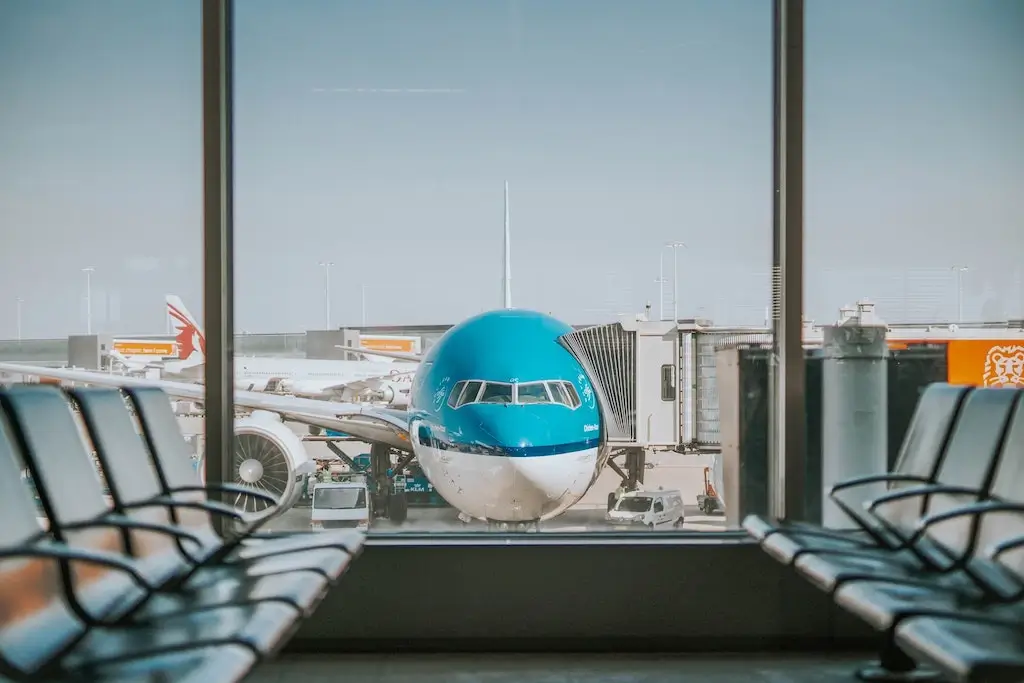
25. Make the most of your layover (optional)
As mentioned above, you should have already planned for your layover.
When leaving the plane, take all your items and hand-luggage with you. You likely won’t be getting back on the same plane.
If your layover is less than 8 hours, wait in the airport, get some food and find a quiet place to rest. Be sure to keep your hand luggage with you at all times. Look at the display screens to find out which gate your connecting flight will be leaving from.
If the layover lasts more than 8 hours, find some accommodation inside or close-by to the airport. Get a few hours of sleep at a hotel or motel before returning to the airport and catching your connecting flight. If you have to leave the airport to get to your accommodation, you will have to go through the security and immigration process again.
Kill some time at the airport on social media – see the 100 best solo travel quotes and Instagram captions!
Arrival at Destination Airport
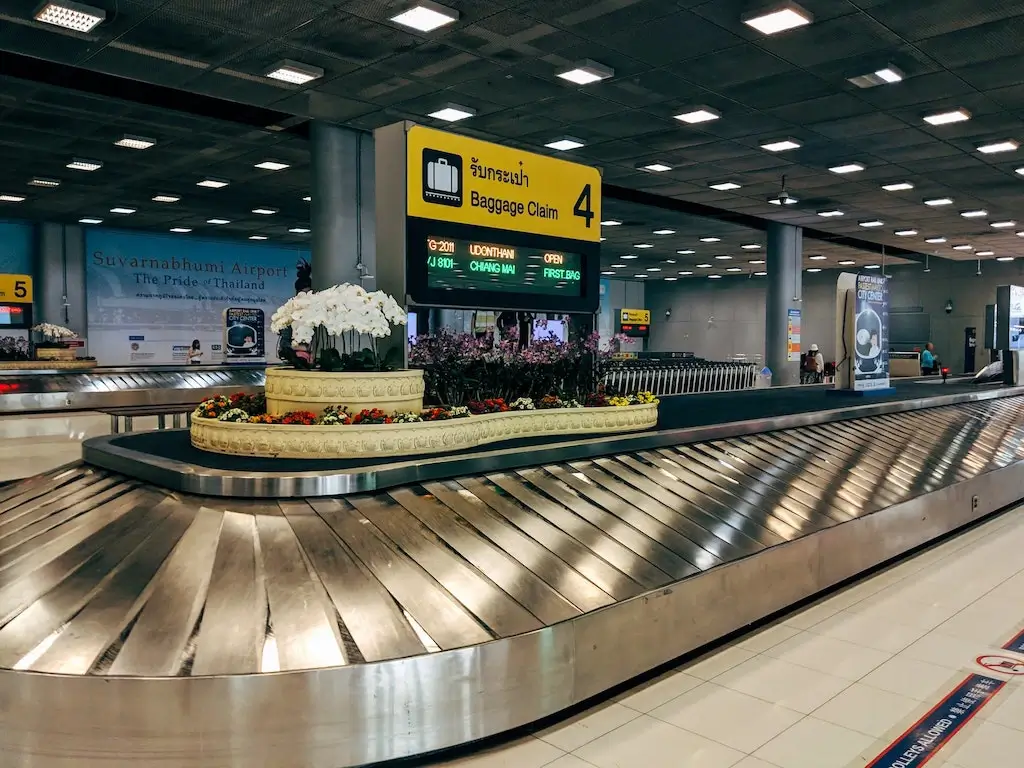
26. Landing
The pilots will inform you that they are preparing to descend about 20 minutes before landing.
This will be the last chance for you to use the bathroom.
The crew will then walk around the cabin and ensure that everyone is ready for landing. Make sure that your table is stowed away and your seatbelt is fastened.
Upon touchdown, the plane will shutter and shake. It will be loud and the tyres will screech. This is normal and there is no need to panic. Soon enough, you’ll be parked.
27. Exiting the plane
As the plane taxis down the runway to the gate, the staff may inform you that you can turn on your phone. If you’re using an E-sim or data roaming, this will be your first chance to receive messages and use the internet.
The crew will only let everyone on the flight stand up once the plane has parked at the gate.
Doublecheck that you have taken all your personal belongings and hand luggage.
Walk off of the plane and follow the signs in the airport to the arrivals hall.
28. Pass through immigration (International flights only)
As you make your way to the arrivals hall, you will come across the immigration gates.
Have your important travel documents ready and in-hand.
Some modern airports may have electronic immigration gates. Simply approach the gate, put your passport face down in the scanner, look up at the camera and wait for the gate to open before proceeding.
If the airport does not have electronic gates or the electronic gates do not work for you, you will have to approach an immigration officer.
Give your passport to the officer and show them your visa if one is required.
The immigration officer may then ask you further questions, such as:
- How long do you plan on staying in the country?
- What do you plan on doing in the country?
- Can you present an itinerary?
- Can you present a certificate of travel insurance?
- Can you present a bank statement with proof of funds?
If the immigration officer is satisfied with your documents and answers, they will stamp your passport. Proceed to the baggage claim area.
29. Pick up your checked luggage
In the luggage pick-up area, look at the screens and find your flight number. The screens should indicate which conveyor belt will dispense your checked luggage.
Wait by the conveyor belt for your luggage to turn up. Be patient, this can take anywhere from 10 minutes to an hour.
When you spot your luggage, approach the conveyor belt, pick it up and make your way to the airport exit.
If your luggage does not arrive, locate the lost luggage desk. The staff will ask you for your flight number and the sticker that you were given when you checked-in. If your luggage can’t be found, the staff will likely tell you to leave the airport and they will deliver your luggage to you once it is located (at no extra cost).
30. Catch transportation from the airport
If you have already arranged transport from the airport to your accommodation, a driver may be waiting for you with a sign displaying your name.
If you have not arranged transport, look for signs leading you to the taxi/Uber rank or public transport.
Once you’re on your way from the airport to the accommodation, you’re done! Congratulations, you’ve just completed your first time flying alone!
10 Tips for Your First Time Flying Alone (+5 Tips for Women)
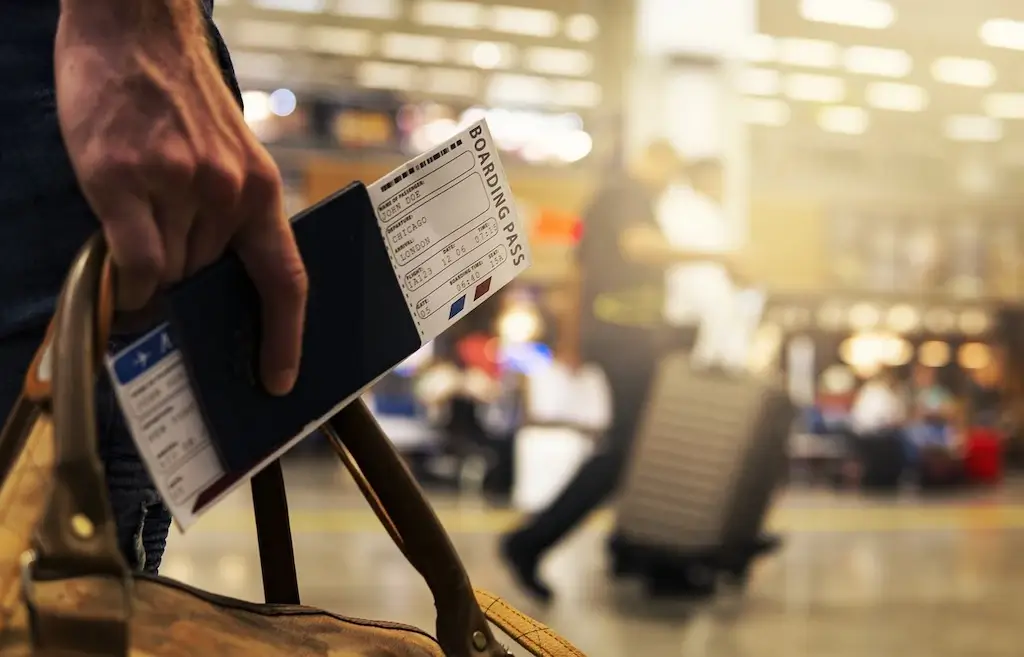
During my first flight alone, I was freezing and bored stiff after realising that most of the in-flight entertainment was in Thai.
I want you to be comfortable and cosy at 12,000m without a worry in the world. Here are my top 10 first time flying alone tips:
- Wear comfy sweats: I don’t care if you’re flying into Antarctica or Antigua, there’s always room for sweatpants and a crew neck on your solo travel packing list (you’re guaranteed to get chilly at some point in your trip). Wear it on your flight so that you’re comfortable and your luggage weight is minimized.
- Juice up your electronics: If your phone dies an hour into your first flight alone, you’re left without music, podcasts and your only means of communication. Make sure you fully charge your appliances the night before leaving and again at the airport before boarding.
- Bring a USB cable: You land in Bangkok with a dead phone – now all you’ve got to do is find your hostel in a 1,569 km² city without any directions! Pack a USB cable so that you can charge your phone mid-flight. Most airlines provide USB-A charging points.
- Pre-download your shows: Got a Netflix watchlist you’ve been meaning to get around to? Pre-download a few hours’ worth of movies and shows on your smartphone or iPad. You never know how good the onboard entertainment will be.
- Lay down during your layover: Most layovers only last an hour or two – in which case you’ll be rushing from one flight to the next. If you’ve got more than 3 hours though, it’s worth looking into whether there are sleeping pods in the airport itself.
- Pack electrical devices and liquids on top: It’s embarrassing having to fumble around in your hand luggage at security. Have all your electronics and liquids (which should already be stored in a plastic bag) at the top of your backpack, so you can slide them out snappily.
- Shake out your backpack/handbag: If you’re like me, you’ve got no idea what all those crumbs and bits at the bottom of your backpack are. Before you pack your luggage, shake your bags out and remove all unnecessary items (old train tickets, used faced masks, coins, etc.).
- Pack a pen and a pin: Two simple items that every solo traveller forgets. The pen is for filing out important forms (e.g. immigration cards). The pin is for changing your SIM card when you arrive.
- Stay sanitised: Avoid catching dysentery on your first flight alone – it will quickly turn your holiday to doo doo. Keep a 100ml sanitiser in your hand luggage and sanitise after using the airport or aeroplane bathrooms.
- Print, screenshot and save to the cloud: Keep your important documents in two formats – printed on paper and screenshotted on your phone. You should also have all your important documents backed up to the cloud or your email in case you lose your phone and need to buy a new one.
5 Tips for Flying Alone as a Woman
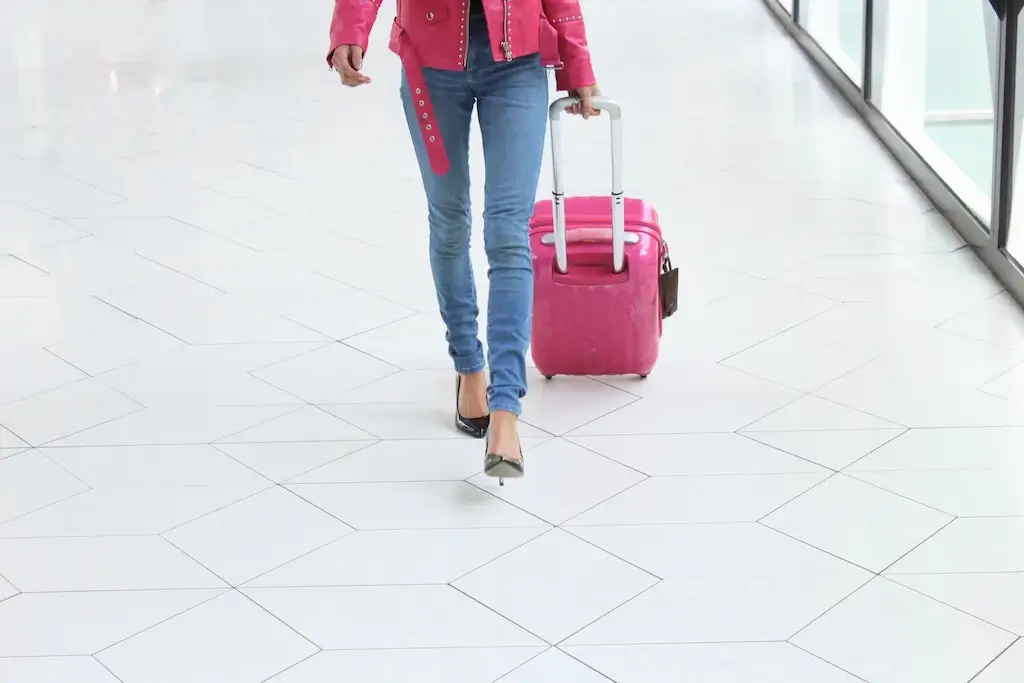
Are you a solo female traveller? Here are an additional 5 tips for flying alone as a woman:
- Tape your cosmetic products closed: Make-up and liquid cosmetics are expensive. You don’t want them to leak all over your stuff. Eyeshadow, blusher or bronzer products can be taped closed. With liquid products, remove the lid, place a piece of plastic wrap over the top and replace the cap.
- Pack make-up wipes and a face mist: The air on aeroplanes is notoriously dry, so whether you suffer from dry skin or not, expect your face to feel dehydrated. Combat the elements by carrying a face mist in your bag. Bring make-up wipes as well to prevent breakouts.
- Carry a change of clothes: Pack a spare pair of underwear, a t-shirt and pants in your hand luggage. If your check-in bags get lost or you accidentally spill food or drink on yourself, you’ll have clean clothes to change into.
- Pack female sanitary products: Even if you’re not expecting your monthly visit, travel can cause havoc with your hormones. Make sure you pack enough sanitary pads or tampons in an easy-to-find pocket in your backpack. If you forget, ask an air hostess.
- Warn staff if you feel uncomfortable: Sat next to a creep? Get up, pretend you’re going to the bathroom and have a private word with one of the air hosts. They may be able to seat you somewhere else.
Travelling alone can feel awkward. I’ve got 6 tips in my article: is it weird to travel alone?
Anxiety and Nervousness: Coping with Your First Time Flying Alone
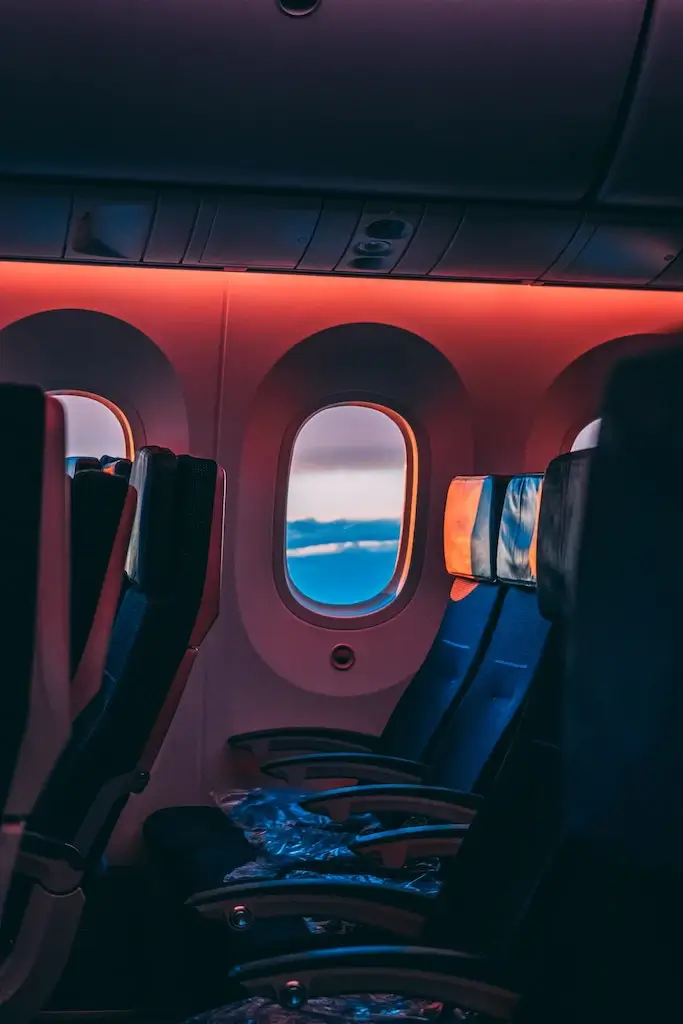
Every solo traveller is a little nervous and anxious about their first time flying alone.
Have I got my passport? Is the flight going to be turbulent and scary? What if the immigration agent questions me?
Let’s put your mind at rest. Here are 10 things you can do if you’re nervous or have anxiety about your first time flying alone.
Pre-flight anxiety, nervousness and stress
- Remember these facts about how safe flying is: Flying is the safest form of transport. No plane has ever crashed due to turbulence. 500,000 people fly safely all over the world every day. The chances of dying in a plane crash are 1 in 11 million (but the chances of dying in a car crash are much higher at 1 in 5000).
- Prepare properly for your first flight alone: Follow all of the step-by-step instructions above on what to do when preparing to fly by yourself for the first time. The more prepared you are, the less anxious you will feel.
- Wear comforting clothes: There’s something comforting about wearing sweatpants and a hoodie. This is my go-to outfit when flying alone because planes get chilly. The comfier you are, the more relaxed you’ll feel.
- Identify your trigger: Figure out exactly what makes you anxious or nervous about flying alone for the first time. Spend some time researching that fear and whether it is warranted. If you identify your anxiety trigger, it will be easier to turn it off when flying.
- Focus on the positives: You have chosen to travel alone for a reason. Perhaps to meet new people, challenge yourself or experience foreign cultures. Whatever your reason, focus on that. Overcoming our fears is what makes us better travellers and stronger people.
In-flight anxiety, nervousness and stress
- Use an anxiety spray: Pack an anxiety spray among the liquids in your hand luggage. Something like Bach’s Rescue Remedy combines 5 flower essences to provide quick comfort and reassurance. Simply spray twice onto the tongue.
- Ask for assistance: If you suffer an anxiety attack, there’s no shame in asking a flight attendant for assistance. The staff are trained for this situation. This happens on almost every flight and the assistants are quick to calm people down.
- Breathe into a paper bag: You’ll find a paper bag located in the pocket of your seat (if you don’t have one, ask for one). If you start to hyperventilate, breathing into the bag repeatedly can help you to remain calm and replace the CO2 in your bloodstream.
- Distract yourself: Make sure that your airline provides in-flight entertainment. Alternatively, bring a tablet device with ebooks, music, movies or podcasts. Keep yourself distracted from your worries.
- Try these anxiety apps: Meditation apps like Calm and Headspace are both popular but require subscriptions. Other apps you might want to try on your first flight alone include Colorfy (adult colouring) and Dare Panic and Anxiety Relief – both free!
For more tips, see my guide on how to overcome fear and anxiety of travelling alone.
Related Posts
Find More Solo Travel Tips on Nomadic Yak

Find more first-time solo travel tips on Nomadic Yak!
Nomadic Yak helps solo travellers to plan journeys that are adventurous and authentic.
Every article is written by me, Harry Dale. I’ve travelled to 40+ countries over the last 5 years – alone.
You’ll find 100s of solo travel tips on how to save money, make more friends, build a social media following and much more.
Plus, you can use my solo travel destination guides to discover international sights and attractions that few other travellers get to witness.




